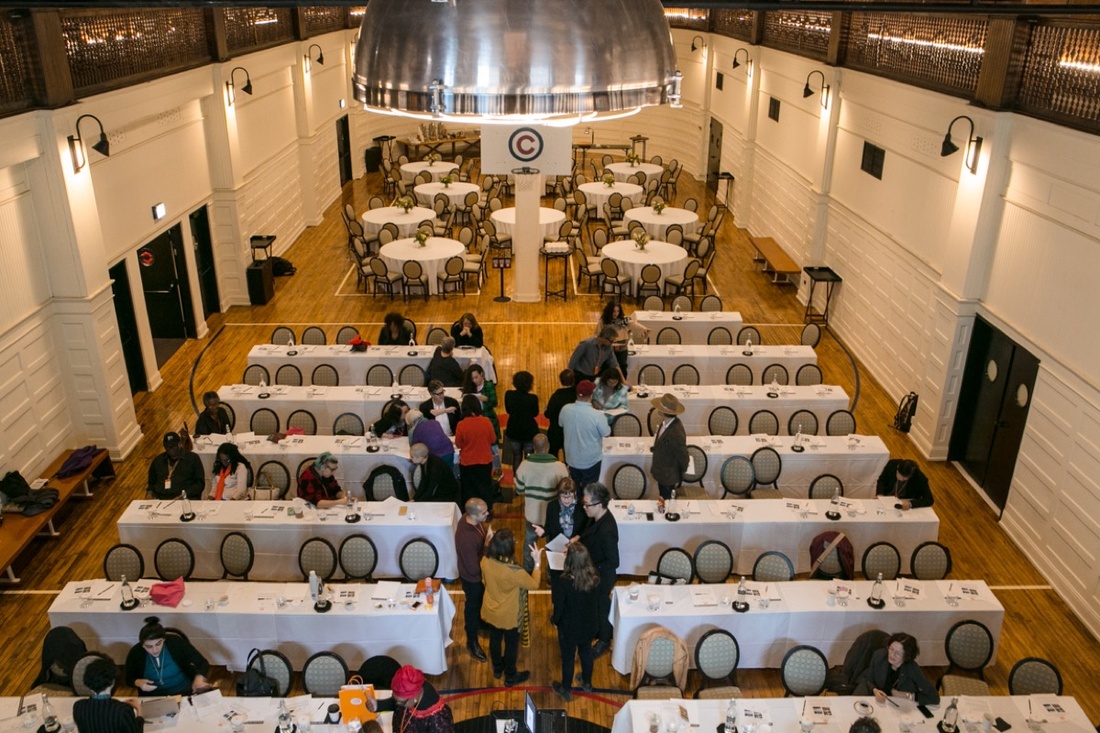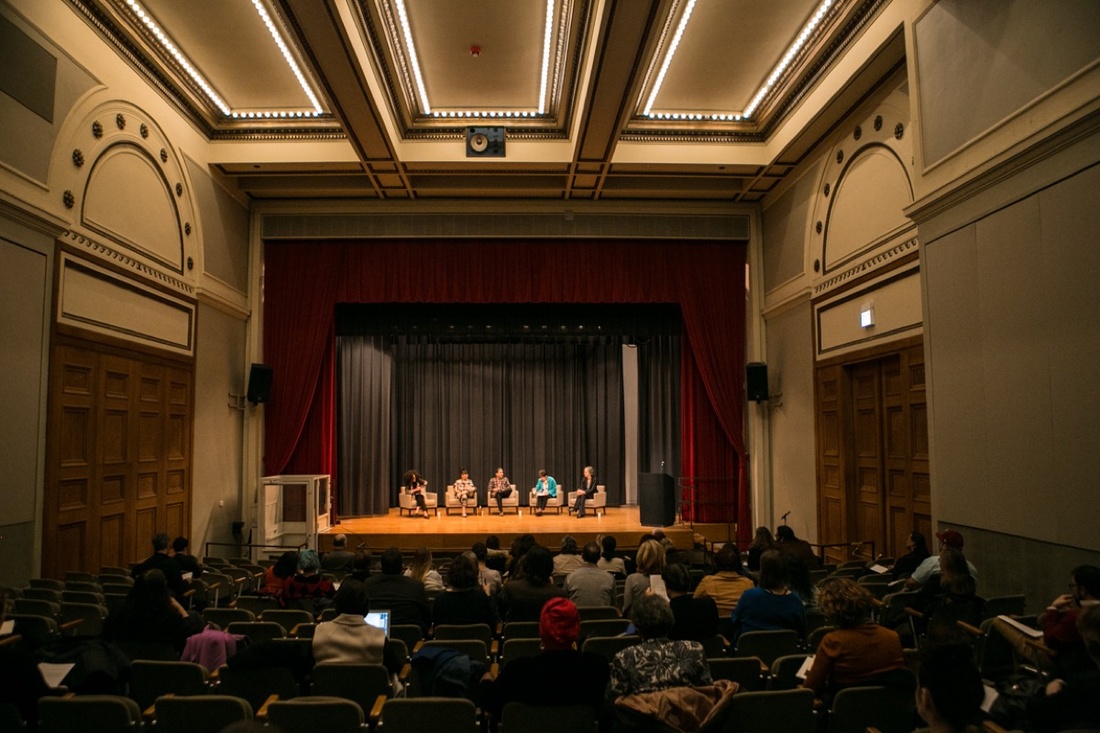A Little-Known Award Program That Backed Barry Jenkins Is Changing Artists’ Lives
 Photo courtesy of United States Artists.
Photo courtesy of United States Artists.
On a recent Monday evening, in a pseudo-Gothic room in downtown Chicago, dozens of artists and philanthropists gathered to talk about the state of the arts. Or, as one speaker put it, to think about “what art can do, and who it’s for.”
It was the annual three-day-long convention of the United States Artists (USA), a little-known art-funding organization that has quietly been handing out $50,000 cash prizes to artists of all media and disciplines for the past 10 years. Among its success stories, the organization was an early and important funder of Barry Jenkins when he was making Moonlight, which won three Oscars this year.
“Nobody was talking about queer black masculinity,” said Deana Haggag, the organization’s charismatic new CEO, over coffee the following morning. “Now it’s in the mainstream.”
Haggag joined USA’s team from her previous role as the executive director of Baltimore’s The Contemporary just seven weeks ago. She has arrived at a critical moment, one in which the organization is taking stock of its achievements and its flaws—and grappling with its identity just 10 years since its founding. And as the Trump administration threatens to eliminate the NEA and federal arts funding finds itself hanging in the balance, the stakes for private funding of the arts have been raised considerably.
This is especially true for an arts funder like USA, whose awards are large enough to make a real impact on the creative community, and, the organization hopes, American society at large—and, crucially, whose grants for artists are completely unrestricted.
Artists are not required to use the money for new work, though more than 80 percent do. A smaller number use the funds to equip new studio spaces, buy software, fund other artists, or in some cases simply to cover general living costs or medical bills.
Though there are upwards of 2,600 award programs in America, with some 1,800 of those being cash grant prizes, the vast majority of them are small, said Holly Sidford, a consultant and strategist for arts organizations who has conducted influential and high-profile reports on arts funding—and who has just produced a 10-year impact report on the USA’s funding efforts for the organization.
“Around 80 percent of award programs are under $10,000, and a lot are limited to one discipline,” said Sidford. “Programs that work across as many as nine creative disciplines? Those are so rare as to be virtually non-existent. The scope, scale, and diversity of USA makes it unique.”
 Photo courtesy of United States Artists.
Photo courtesy of United States Artists.
The organization may be doing vital work, but Sidford found in her research that its low profile means that artists who receive the award draw little press attention and can’t capitalize on the platform and prestige in the way that recipients of a McArthur, Guggenheim, or Creative Capital award can.
“We joke that we’re the $25 million organization no one’s ever heard of,” said Haggag. Indeed, two attendees at the Chicago assembly admitted to never having heard of the award, or thinking it was spam, when they received notification. “Having less visibility has been good in really not putting any expectations on the artists,” Haggag said, “but it feels like today we need to amplify the voices of these artists.”
USA was founded in 2006, partly to fill a gap that the National Endowment for the Arts (NEA) left when it cut individual artist grants in 1995. Following a report published in 2003 about the experience of artists in America, four founding donor organizations—Rockefeller, Rasmuson, Ford, and Prudential—joined forces to create USA. In order to effectively survey the whole country’s artist pool, they chose a model in which some 1000 nominators are tapped to provide names of talented candidates, who are then considered by a committee.
Each year, current awardees and alumni (who now number 488) assemble to present their art, to discuss how to improve the program, and to catch up. “We all fall in love with each other,” said Tanya Aguiñiga, a Mexican artist and 2006 USA Fellow who is based in L.A. She creates furniture and textile works, many of which engage with the politics of the U.S.-Mexico border.
Among other fellows who presented at this year’s event were well-known artists like the Indian writer and journalist Amitava Kumar and the American sculptor Janet Echelman—who creates vast, ethereal artworks made of netting that she suspends mid-air between buildings in urban spaces, so that they appear like architectural auroras in the sky.
But the award list also includes individuals—largely in the categories of “Craft” and “Traditional Arts”—for whom few such funding opportunities exist.
Cherice Harrison-Nelson, a traditional beadworker from New Orleans who creates beaded costumes for Mardi Gras, told me over breakfast that, where she’s from, people are the museums; they wear their art. Ernie Marsh, a cowboy from Oklahoma, was in attendance to represent the extraordinarily intricate metal belt clasps that he crafts by hand. And Vicky Holt Takamine, a Hula dancer from Hawaii, in a presentation of her work, spoke of the way she uses Hula as a form of resistance and activism.
“I keep thinking about the kind of person in my life, who’s not in the arts, who I wish had been in that room yesterday for those presentations, because they’re so moving about humanity,” said Haggag.
 Photo courtesy of United States Artists.
Photo courtesy of United States Artists.
Indeed, one of the points of feedback that USA has received from former fellows through the report is that, for the prize to increase its value—not only to individual artists but also to communities across America—the organization should find a way to broaden its visibility and use that platform “as a bully pulpit” from which to make an argument for why art matters.
“I love being here because it’s reminding me that I don’t actually live in a bubble,” said Haggag in a closed-door session about how to illuminate the value of artists in America. “Culture does not exist in a bubble. It’s all over the country. Art is being made in every culture, in every state.” One artist in the audience offered: “Our story is the story of arts in this nation.”
The way in which USA captures a snapshot of cultural practices around the nation isn’t accidental, nor has it been overlooked as a key asset—the organization has sponsored artists in every state except Delaware over its 10-year lifespan, and they’re working hard to find the funds to make it to all 50 states. The challenge, now, is to broadcast that picture around the country.
“Being here, you see this microcosm of American life,” Haggag reflected in person. “I really needed that this year in light of everything that’s been happening. And to know that these people are initially strangers to each other. We’ve gotten to a place where we identify more with people who hate one another than people who don’t.”
“I feel like the arts is one of the few places where any progress can be made in that arena,” she said. “It can make people more empathetic.”
—Tess Thackara


No comments:
Post a Comment